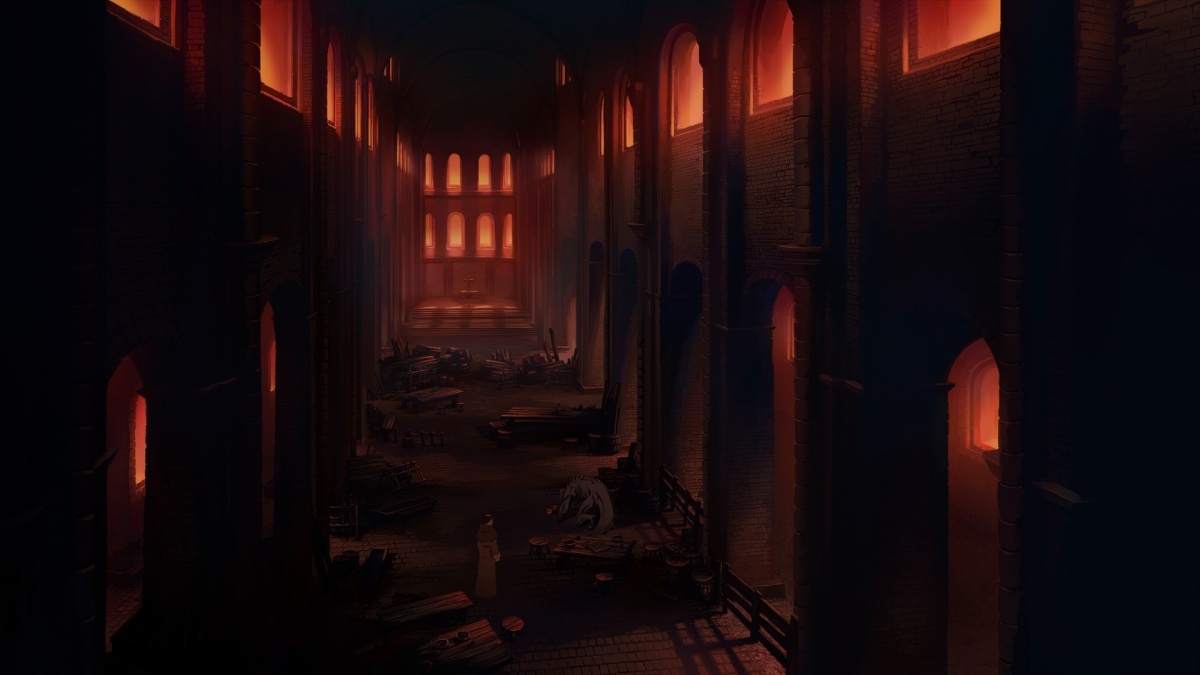Ken Follett's The Pillars of the Earth (PlayStation 4) Review
By Josh Di Falco  13.11.2017
13.11.2017

Visual novels and interactive stories are slowly becoming a dime-a-dozen with there being many releases coming in this genre. Daedalic Entertainment's latest point-and-click venture adapts the thousand-page novel from author Ken Follet, with his much acclaimed The Pillars of the Earth. Splitting the long story into three separate parts, this first instalment details the first seven chapters. Introducing three playable characters who the story is told through, this is a beautifully hand-drawn game that retells the riveting story set in 12th Century England. After checking out the game on PC and Xbox One, Cubed3 now covers the PlayStation 4 iteration.
Tom Builder is a hardened man who begins the game in-between moving his family to another town where he is hopeful of getting a job as a builder. Although his ultimate goal is to build a grand cathedral that will stand the test of time in order to give meaning to his life, he decides to settle for building regular houses, and sheds if it comes to that, in order to better support his two children and his pregnant wife. This entire prologue works wonderfully, as it introduces all the key elements of the gameplay, while also introducing this particular family to newcomers. The emotional beats in this sequence can be felt with every line of dialogue, as the family's struggle to survive out in the wild sets the tone for what is a pretty sombre story.

The art style is beautifully drawn, and each scene presents a rather dull colour palette that is reflective of the treacherous times that this story lives in. Simply put, this world is not a happy place. To give context, the King of England has died, with his rightful heir perishing in a sunken ship. As such, the King's daughter, Maud, is in a battle for the throne with her cousin, Stephen of Blois. While this is the overarching story that is eating up the lands, the more direct story featuring Tom, a monk called Philip, and a young forest-boy call Jack play small roles, as their impact ripples out into the larger throne-battle.
The mechanic is stock-standard visual-story gameplay, where the characters can move around the scenes and locations, and interact with different environmental elements, or initiate dialogue sequences with other characters. On-screen nodes mark different points-of-interest, with three different interactions mapped to the shape buttons: "think," "action," and "use item." Items are picked up along the way, and the right stick controls the item wheel, as equipping certain items and using them on points of interest can combine their use in order to solve the various puzzles and obstacles that the characters find themselves in.

These moments are very few, as the game focuses heavily on the storytelling aspect and there is minimal focus on the actual gameplay elements. Generally, each scene plays out with a series of points of interest that then initiates new scenes. There is nothing here that threatens to reinvent the wheel, nor bring anything new to the established genre. While that isn't all bad, The Pillars of the Earth does suffer from a severely slow movement speed. Moving from point to point can be an arduous experience, and sometimes the story also suffers from really slow moving moments that drag down the momentum of the story. While there is a button to speed up character movement, it only increases the basic walk into a sort of power walk that barely seems to even work. The issue is only further amplified by the need to retread through previous areas constantly to further the story, thus feeling sluggish overall.
Conversations between characters also initiates a spate of responses with a dialogue wheel, and choosing different responses to situations only really causes mild dialogue changes, at best. Very rarely do different decisions seem to have any sort of major or long-lasting effect at all. Although, with this game only being the first instalment, it remains to be seen how the decisions impact later chapters. Remaining silent through conversations is also an option, although it is sure to irritate the other conversers, but the game is pretty forgiving for missing certain cues. Very rarely does an action go punished, as the story just seems to always proceed further, regardless what choices are made in the end, with the same outcome each time.

There are optional information pieces that serve a contextual purpose for the story, yet they aren't needed to get the most out of the base story anyway. Still, some of these can be easily missed, and replaying the game to find some of these pieces also doesn't feel as rewarding as perhaps it could have been. However, the music in The Pillars of the Earth is a lovely and peaceful soundtrack that helps add character to each of the locations, while giving them their own unique flavour and style of sound.
Unfortunately, it does suffer from some graphical hardships that detract from the experience. Sometimes, during scenes, a head may detach from the body of a character that is currently talking, while the frequent sound cuts during the loading screens seem messy and grating. Towards the end of the adventure, during the review process, the programme even crashed and while a reboot was enough to fix the issue, it was still a further sign of just how unpolished the technical aspects are.

Cubed3 Rating
Very Good - Bronze Award

Ken Follet's The Pillars of the Earth is a beautifully hand-drawn retelling of the original novel that visualises the story through the eyes of three different characters: Tom Builder, Philip, and Jack. They each play a role in the overall story that intertwines with each other, with the threat of a greater war over the kingship looming over everyone's heads. Uneasy alliances are formed, and major moves are made that cannot be undone, while Tom is focused only on building his grand cathedral, while Philip is trying his best to restore the Priory to its former glory, and young Jack is simply trying to find his place in the world of men. While the story can be slow-going due to the sluggish gameplay and technical limitations causes graphical headaches, this is a great way to introduce new people to the wonderful story.

![]() 7/10
7/10
![]() 0
(0 Votes)
0
(0 Votes)
 Out now
Out now  Out now
Out now  None
None  Out now
Out now Comments
Comments are currently disabled

 Sign In
Sign In Game Details
Game Details Subscribe to this topic
Subscribe to this topic Features
Features






 Top
Top

